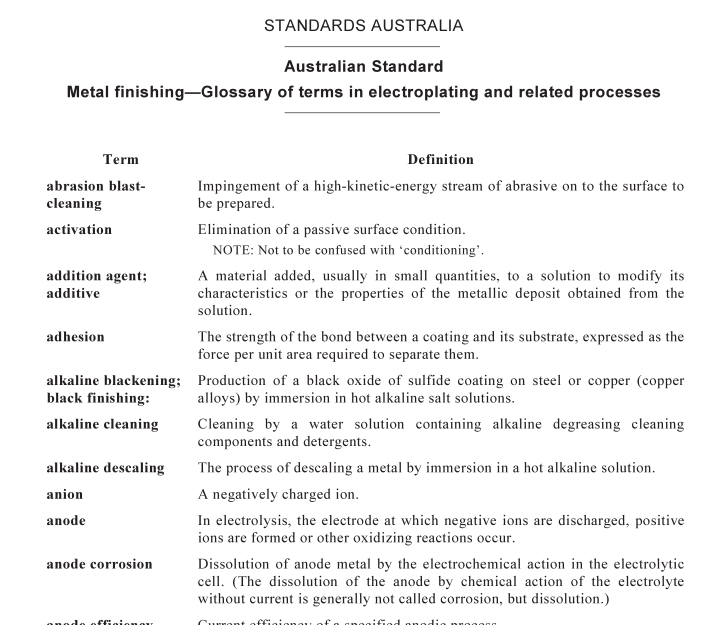AS 4108 pdf download – Metal finishing—Glossary of terms in electroplating and related processes

AS 4108 pdf download – Metal finishing—Glossary of terms in electroplating and related processes
anolyte
In a divided cell, the portion of electrolyte on the anode side of thediaphragm and the electrolytes surrounding the anode in a single cell.
autocatalytic plating
Deposition of a metallic coating by a controlled chemical reduction that iscatalyzed by the metal or alloy being deposited.
auxiliary anode
A supplementary anode employed during electrodeposition to achieve adesired thickness distribution of the deposit.
auxiliary cathode
See ‘thief” .
average coating
The mean value of not fewer than five local thickness measurements that are
thickness
evenly distributed over the significant surface of a single piece, or the valueobtained using the gravimetric method of thickness determination.
baking
Heating to low temperatures before or after electroplating or autocatalyticplating process steps to reduce residual stresses or to remove gases causingembrittlement effects.
barrel electroplating
A barrel process, (see barrel processing) electrodeposits which are applied toarticles in bulk: in contrast to vat plating, see ‘vat plating”.
barrel processing
Mechanical, chemical or electrolytic treatment of articles in bulk in a rotatingcontainer. Examples are barrel burnishing, barrel polishing, barrel cleaning,barrel electroplating.
base metal (basis)
Metal in the form of sheet,coil, cut lengths,strip, extruded sections,forgingsor castings prior to surface treatment.
basis material; basis Material upon which coatings are deposited or formed, (see ‘substrate’).metal
batch average
The average thickness of the coating on all the items of an inspection batch
thickness
as determined on a representative sample
bead blasting
See “blasting: bead blasting’.
bipolar electrode
A conductor immersed in the electrolyte between the anode and the cathodebut not connected to the power supply. The part of the conductor nearest theanode acts as a cathode and that nearest the cathode acts as an anode.
blackening: black
The production of a black finish, see “alkaline blackening’.
finishing; black oxide
treatment
blasting:
A process in which solid metallic,mineral or vegetable particles areprojected at high velocity against the work piece for the purpose of cleaning,abrading or peening its surface. If the process is principally used forimparting hardness or compressive stress, it is normally termed peening (seeshot peening’).
abrasive blasting
General term for blasting using abrasive particles.
bead blasting
A process whereby small spherical glass or ceramic beads are propelledagainst a metallic surface.It is carried out in either wet or dry state.
cut wire blasting
Blasting with short cut lengths of wire (ferrous and non-ferrous).
grit blasting
Abrasive blasting with small,irregularly shaped pieces of steel or cast iron.
shot blasting
A process whereby hard, small,spherical objects (such as metal shot) arepropelled against a metallic surface.
NOTE:To be distinguished from ‘shot peening’.
wet blasting
Blasting with a liquid medium or slurry containing abrasive to clean delicateparts of close dimensional tolerances and to enhance the fatigue resistance ofhardened parts.
blast-cleaning
Solid material intended to be used for abrasive blast-cleaning.
abrasive
blister
A dome shaped defect in a coating arising from loss of adhesion betweencoating and substrate.
blueing
The formation of a very thin blue oxide film on steel either by heating in airor by immersion in concentrated oxidizing solutions.
bright anodized
Anodized aluminium with a soft bright to a high specular reflectance as a
aluminium
primary characteristic.
bright dipping
lmmersion in a solution to produce a bright surface on a metal.
bright clectroplating
A process that produces an electrodeposit having a high degree of specularreflectivity in the as-plated condition.
bright electroplating The range of current densities within which an electroplating solutionrange
produces a bright deposit under a given set of operating conditions.
bright finishing
A finish with a uniform non-directional smooth surface of high reflectivity.
brightener
An addition agent in an electroplating or autocatalytic solution that improvesthe brightness of the deposit.
bronzing
The application of a chemical (immersion) finish to copper and copper alloysor, alternatively, to copper and brass electroplated metals, to alter the colourof the surface.
brush electroplating
A method of electrodedeposition in which the electrolyte is contained in apad or brush in contact with the anode. The pad or brush is applied to the partto be processed, which is given opposite polarity.
brush polishing
A particular method of electropolishing (see ‘electropolishing’) in which the
(electrolytic)
electrolyte is contained in a pad or brush in contact with the cathode. The pador brush is applied to the part to be processed,which is given oppositepolarity.









